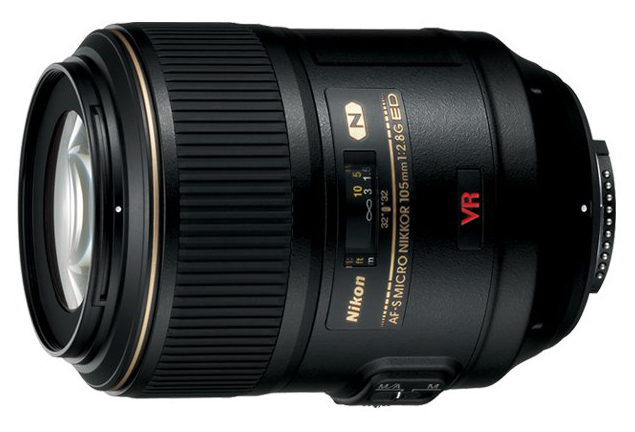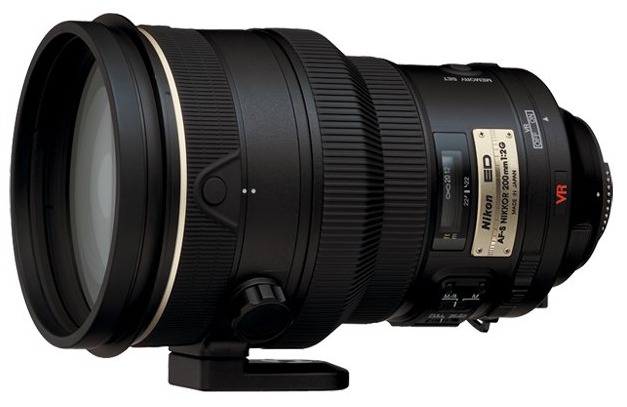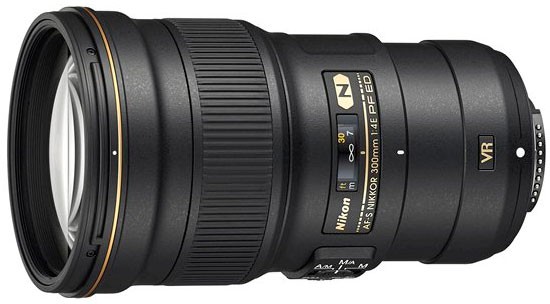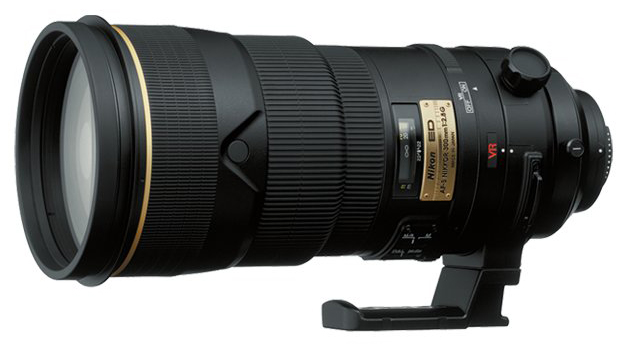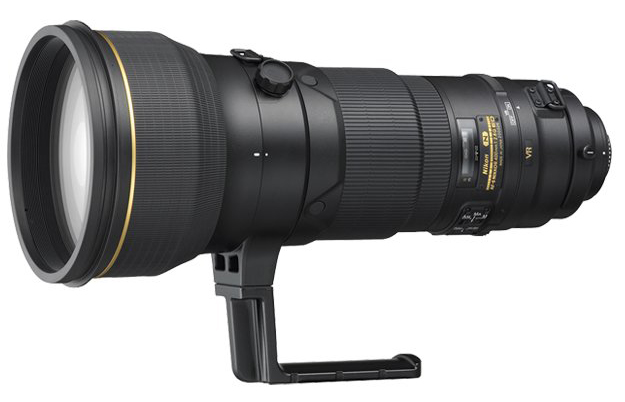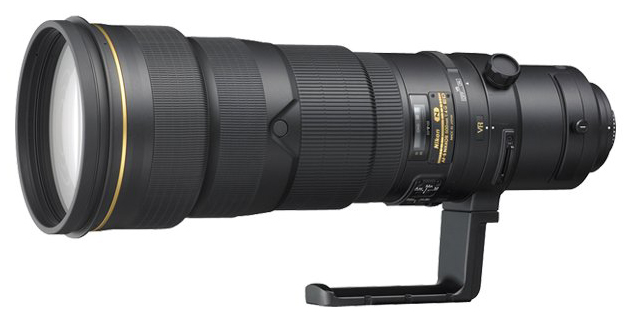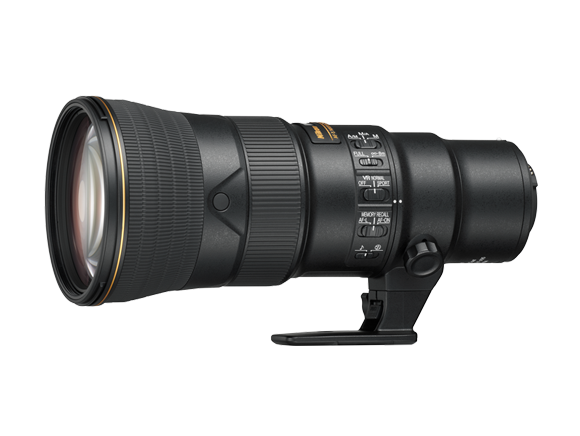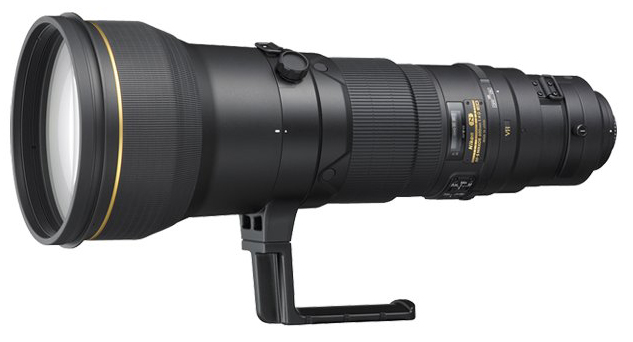AF-S Micro-Nikkor 2.8/105 mm. G VR
This is the world's first SLR lens for macro-photography with a built-in Silent Wave Motor and a vibration reduction system! In this very useful focal length Nikon offered since 1984 excellent optics. The popular manual 'father' was succeeded by the auto focus micro-Nikkor - featuring floating elements and a focus limiter - in 1990, followed by the D-version in 1993. In February 2006 this VR-version was introduced. It has an optical construction of 14 elements (of which the element right behind the aperture blades is made of ED-glass) in 12 groups, nano-crystal coating on some elements and a Silent Wave Motor for very fast focusing down to 31 cm. at a comfortable object/working distance of 15 cm. With its 790 gram this lens gives a stabile grip. The lens comes with hood HB-38.
AF-S Nikkor 2/200 mm. G VR
This beautiful lens - introduced in 2004 - has nothing to do with the manual focus Nikkor 2/200 mm. The optical design of this new lens - AF-S VR Nikkor 200mm. f/2G IF-ED - is totally new. The auto focus version has an optical construction of 13 elements in 9 groups (the manual version 10 elements in 8 groups). 3 elements are made of ED-glass and one of Super-ED* glass. It has a silent wave motor for quick internal focusing, distance data transfer and the vibration reduction feature + focus memory recall. The latter enables the photographer to set the focus on a certain distance. The VR-system has 2 settings: Normal for handheld shooting and Active for handheld shooting while sitting on/in e.g. a car or on a motor bike. Needle sharp at all apertures and distances, down to 1.90 meter. A pity is the G-mount, thus having no aperture ring, and its weight: 2900 gram. Mid September 2010 Nikon introduced a successor of this fine lens, having the same optical construction but some elements have the famous Nano Crystal Coating. The VR-system has been improved as well. 52mm. drop-in filters can be used. The lens weighs in at 2930 gram and will take lens hood HK-31.
AF-S Nikkor 4/300mm E PF ED VR
This long title belongs to a very special Nikkor FX format lens, introduced early January 2015. As the first Nikkor lens (for full-frame photography) this lens features a fresnel lens, making it considerably lighter (545 gram) and shorter (75 mm.) than its predecessors and competitors. Its optical construction consists of 16 elements in 10 groups. One element (the second from the front) is made of ED-glass, the fourth lens from the front is a fresnel lens. Some elements have a nano crystal coating and some have a fluorine coating.The lens can be focused down to 1.40 meter. It weighs in at 775 gram, has a filter thread of 77 mm. and uses the HB-73 hood.
AF-S Nikkor 2.8/300 mm. G VR
This VR-version of the very popular fast 300mm. came on the market in September 2004. It has a redesigned optical system of 11 elements in 8 groups (3 are ED), plus a protective front lens (this time a meniscus lens). Some elements are coated with the new nano-crystal coating., 52mm. drop-in filter can be used. This needle-sharp and fast lens weighs in at 2.85 kilo. Mid December 2009 Nikon introduced an upgraded version of the lens; optical system remains the same, but an auto focus with manual override is the new feature. The lens has now three focus modes (auto focus with manual override, AF priority and manual priority).
The three beautiful lenses shown below were all introduced in August 2007. They all have a built-in Silent Wave Motor, at least 3 lens elements of special Extra Dispersion (ED) glass and a protective meniscus front lens and they may be used with 52 mm. drop-in filters. On some elements Nikon has used its famous nano-crystal coating and all three are featuring Nikon's improved vibration reduction system (VR II). Needless to say that these lenses are razor-sharp at all apertures and all distances! Any image made with these lenses will impress you (as well as their price!) AF-S Nikkor 2.8/400 mm. G VR
The optical formula of this lens consists of 14 elements in 11 groups; it can be focused down to 2.8 meter. The lens weighs in at 4620 gr. and the best hood is HK-33. Mid April 2014 Nikon replaced this popular lens by an improved version with an altered optical formula: 16 elements in 12 groups + 1 meniscus protective glass with fluorite coating. Two elements are made of fluorite glass and two others made of ED-glass. Some elements are also coated with Nano Crystal coating. Barrel components are made of magnesium to lower the weight down to 3800 gram. The tripod collar has got bearings to ease rotation. The lens is taking 40.5 mm. screw-in filters and a HK-38 hood. Minimum focusing distance is 2.6 meter. This sophisticated lens features an extra SPORT Vibration Reduction for capturing very fast moving objects.
AF-S Nikkor 4/500 mm. G VR
The optical formula of this mid-2014 introduced FX-telelens consists of 14 elements in 11 groups, close focus down to 4 meter, weight is 3880 gr. and the best hood is HK-34. Early July 2015 an improved lens was introduced. The new one has 16 elements in 12 groups, of which no. 1 and no. 2 from the front are made of fluorite glass, 3 others are made of ED-glass. Some of the lenses have a Nano Crystal coating and the protective glass at the lens front features a fluorine coating. The lens weighs in at 3090 gr. and can be focused down to 3.6 meters. 40.5 mm. filters can be attached to the very rear of the lens.
AF-S Nikkor 5.6/500 mm E PF ED VR\
Late August, 2018 Nikon introduced the earlier announced super telelens with VR and a fresnel lens. Its special optical formula consists of 19 elements in 11 groups. 3 elements are made of ED (extra dispersion) glass and one element is a fresnel lens, which makes it possible to produce a lighter and shorter telelens. Some elements have the nano crystal coating, while the front lens has a fluorine coating. The entire lens is dust- en drip resistant, can be focused down to 3 meters, uses 95 mm filters and weighs in at 1460 gram.
AF-S Nikkor 4/600 mm. G VR
Mid 2014 this lens was announced. The optical formula consists of 15 elements in 11 groups, can be focused down to 5 meter, weights in at 5060 gr. and uses hood HK-35. Early July 2015 an improved and even more sophisticated lens was introduced.This one has 16 elements in 12 groups, of which no. 1 and no. 2 from the front are made of fluorite glass, 3 others are made of ED-glass. Some of the lenses have a Nano Crystal coating and the protective glass at the lens front features a fluorine coating. The lens weighs in at 3810 gr. and can be focused down to 4.4 meters. 40.5 mm. filters can be attached to the very rear of the lens.
AF-S Nikkor 5.6/800 mm. G VR
Mid July 2012 Nikon announced the introduction of this very long tele-lens at the 2012 Photokina Camera Fair in Germany. The official introduction came at the end of January 2013. At the same time an exclusively made teleconverter was introduced: Nikon TC-800 - 1.25E ED. The new 'stove pipe' of 800mm has an optical formula of 20 elements in 13 groups. 2 elements are made of fluorite, two other elements are made of Ed-glass and in front one will find a protective glass element. Some elements have a nano crystal coating to eliminate internal reflection. The lens has G-mount, the well-known silent wave motor and the latest vibration reduction technology, which makes hand-held photography possible. Although it is hard to believe that a photographer will run around with this lens for a long time as the huge pipe weighs in at 4,590 gram. Filters with a 55mm thread can be screwed in at the back; the best hood is the HK-38. The special teleconverter will convert the above lens into a tele-lens of 1000mm. with a maximum effective aperture of f/7,1. Newer digital SLR cameras with an AF-sensor able to master f/8-lenses will easily focus the combination down to 5,9 meters. The optical formula of the teleconverter consists of 5 elements in 3 groups. It is the first converter with an ED glass. The converter weighs in at 135 gram, making the whole combination a nearly 5 kilo heavy instrument for extreme telephotography.
|
